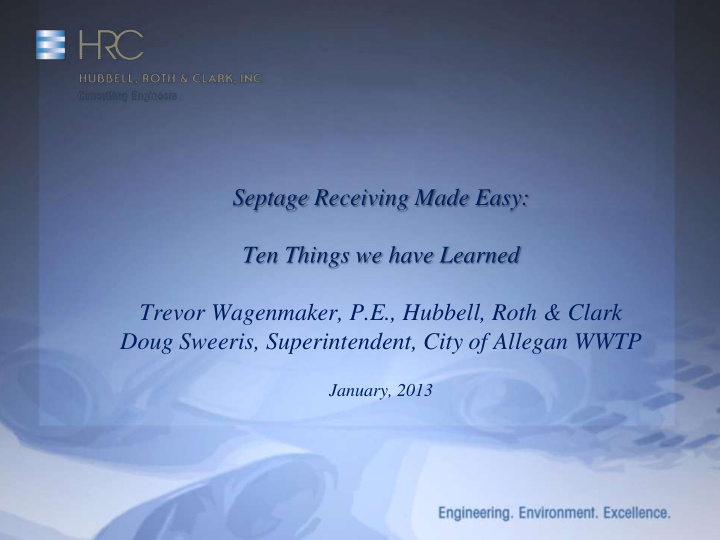



Septage Receiving Made Easy: Ten Things we have Learned Trevor Wagenmaker, P.E., Hubbell, Roth & Clark Doug Sweeris, Superintendent, City of Allegan WWTP January, 2013
Allegan Plant History Original plant built in 1938 along Kalamazoo River Major expansion in 1970’s to increase capacity to 4.0 mgd and provide secondary treatment
Plant History (cont.) Addition of new tanks in the 1990’s to accommodate loading from Perrigo Corporation Major Renovation project in 2008 to replace most process equipment and double organic treatment capacity. Added septage receiving as part of this project. Currently doing renovations on Treatment Train No. 3 built in the 1990’s Planned construction project in 2013 to add a second Septage receiving station and second UV disinfection channel.
Why Receive Septage? Revenue Source for Plant to maintain operations and pay down debt Additional points on SRF program Provides Service to the surrounding Communities Good for the Environment Treated/Screened/Regulated
Up Front Planning & Marketing to develop Business Plan Do preliminary investigation to determine Market Size Solicit letters from local septage haulers to request service Educate City Council/Leadership about benefits and risks Secure Funding for necessary improvements Talks at County Health Department septage meetings to inform local septage haulers Mailings to local septage haulers/City Website Coordinate with MDEQ/Apply for Septage Receiving Authorization Provides for 25 mile radius zone for required hauling/disposal
Radius Map
Septage Treatment Overview Allegan’s receiving station has automatic filling system with card reader, automated valve, rock trap, flow meter and septage fine screen (0.25 inch) with 400 gpm capacity. • A prefabricated building was built next to an existing, unused sludge storage tank which was rehabed/retrofitted for septage/WAS storage/mixing
Septage Treatment Overview (cont.) WAS is directed to aerated mix tank and mixes with septage for approx. 3 days detention time
Septage Treatment Overview (cont.) Two PD pumps pump sludge from this tank to one of three on site storage tanks for aerobic digestion, settling/thickening, decant before final sludge removal for land application of biosolids City follows EPA 40 CFR 503 rules for land application
Wastes Received Allegan receives: Residential septage waste Commercial septage waste Food establishment waste if mixed with domestic septage Mobile home park raw waste Porta-Potty waste Industrial waste (preapproved only)
Total Septage Received Septage Received (gal) 4,000,000 3,500,000 3,000,000 2,500,000 2,000,000 Septage Received (gal) 1,500,000 1,000,000 500,000 0 2010 2011 2012
Revenue Received Revenue Received ($) $250,000.00 $200,000.00 $150,000.00 Revenue Received ($) $100,000.00 $50,000.00 $0.00 2010 2011 2012
Septage versus Sludge Tank Decant P TSS Sludge Decant (mg/l) Septage (mg/l) BOD Ammonia 0 1,000 2,000 3,000 4,000 5,000 6,000
Total Sludge Hauled from Plant Gallons Applied to Farmland 2,500,000 2,000,000 1,500,000 Gallons Applied to 1,000,000 Farmland 500,000 0 Sludge Hauled Prior to Sludge Hauled After Septage (per year) Septage (per year)
Provide Good Customer Service to Maintain/Increase Market Share Interact with Septage Haulers Ask them what would make their experience better Keep a tidy facility Get the Septage Haulers to “Buy - in” to keeping it clean Provide “Perks” Annual Open House Door Prizes Luncheons Provide rubber gloves Recognition to Largest Haulers – Jackets, hats, calendars, etc.
Invoicing Load tracking should be automated Billing once per month or incentive to prepay Allow for flexibility in payment Keep up with delinquent accounts Bottom line – operate as a business
Unloading Operations Easy access and turn around/pull through 24 hour/7 day access, automatic gates Easy unloading Security cameras in place
Unloading Operations (cont) Washdown area with hoses/fittings provided for different sizes Forced air compressor unloading system Equipment reliability Schedule maintenance during off times
Unloading videos
Unloading
Sampling
Unloading Video with Air Supply
Air Supply Unloading System
Inside Station while Unloading
Competitive Rates Rates should cover: Capital costs Debt repayment for septage receiving facility Debt repayment for any oversizing of other processes to accommodate septage Operations costs Electricity Dumpster for screenings disposal Water bills Manpower costs Equipment maintenance/replacement Analytical testing Sludge disposal – land application, etc.
Competitive Rates (cont.) Assume a conservative amount of septage in determining fixed cost repayment – if additional septage received, this provides cushion Compare your rates with your competitors! If out-of-line, why?? Pay-per-load or per-gallon Distance versus convenience versus rates
Questions
Recommend
More recommend